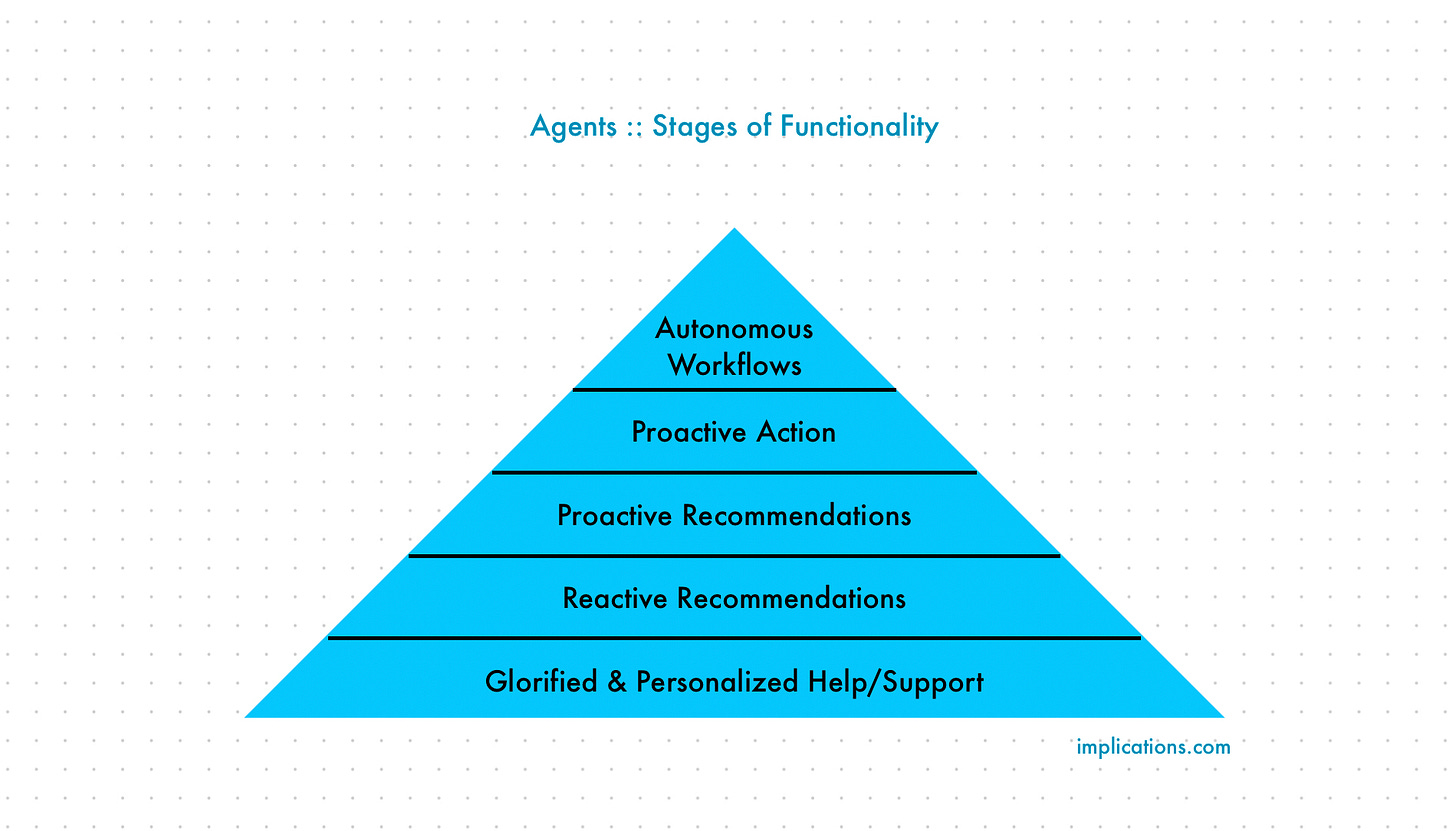The Data Wars & Reimagining Your Product During a Platform Shift
What are the new tactics to get the data you need and build the winning interface? How should product leaders navigate a platform shift, and what learnings must we incorporate?
Edition #30 of Implications.
This edition explores a collection of insights and implications for your consideration, including (1) what product leaders must do to reimagine their products amidst a platform shift and what key learnings have revealed themselves, (2) what may transpire from the impending data wars, and (3) some surprises at the end, as always.
If you’re new, here’s the rundown on what to expect. This ~monthly analysis is written for founders + investors I work with, colleagues, and a select group of subscribers. I aim for quality, density, and provocation vs. frequency and trendiness. We don’t cover news; we explore the implications of what’s happening. My goal is to ignite discussion, socialize edges that may someday become the center, and help all of us connect dots.
If you missed the big annual analysis or more recent editions of Implications, check out recent analysis and archives here. A few recommendations based on reader engagement:
We talk about “agents” a lot these days, but what stages of functionality should we expect in the coming months and years across the products that embrace them? We explored this further here.
Amidst the rapid pace of change in technology these days, I recommend revisiting “the law of displacement speed,” which explains why, when applications or services are able to displace each other at a rapid and regular cadence, the result is either commoditization or platform-level displacement.
Finally, as the season warms for us east coasters, my daily runs have become far more enjoyable. Resurfacing 12 insights I hold dear, learned while running, which have had a big impact on how I lead and make decisions across various parts of my life.
And now, onto edition 30 of IMPLICATIONS.
Amidst a platform shift, what must product leaders do to reimagine their products?
The companies I am involved with, and the founders I advise, span the spectrum of products built pre and post the age of AI. Also, as part of my role at A24, I am constantly evaluating the products and processes behind every function of a fast-growing studio (a decent proxy for what many other high-growth businesses are now going through). I am struck by the speed at which pre-AI tools are feeling antiquated.
I recall the period when most New York toll booths went from being staffed by toll takers to “fast lanes” enabled by sensors, to the entire “toll” concept being ripped out altogether, replaced by high-speed cameras capturing your license as you speed by. Suddenly, the idea of having a toll-induced pause that causes any form of slowdown became unimaginable. My kids won’t even know what a tool booth is, let alone believe they even existed.
During platform shifts in which a new technology becomes widely available – like the transitions to electricity, to computers, to the internet, to mobile, to AI - you know the shift is real when tools and practices that we’ve used for many years suddenly start to feel like they are holding us back. A platform shift causes us to reimagine everything while (and perhaps because) we become frustrated with the current soon-to-be-antiquated aspects of our lives that linger.
I am feeling this sensation often. When I go into spreadsheets trying to make sense of various pieces of data, I realize that the lack of a fine-tuned LLM layer makes this an antiquated exercise. Spreadsheets are starting to feel like data silos compared to AI-native database products. When I use voice dictation on my iPhone or search for something and fail to find it due to an inexact descriptor, I notice the lack of AI and feel the cruft of rapidly antiquating software. The rules and filters that I set up in my native email clients are far inferior to the basic email agents that are emerging from startups.
Anything optimized for web or mobile rather than AI will start to feel outdated. How product teams react to this shift is crucial. Too many established companies will fall short because they only augment their offerings instead of fully reimagining them. So how should product leaders proceed, based on these implications?
Re-anchor yourself with the customer. When you’re not sure what to build or how to build it, double down on empathy with the customer suffering the problem you want to solve. You’ll often learn that the solution you have in mind is a little (or a lot) off from what’s required to really engage the customer emotionally and practically. A platform shift challenges us to recalibrate our solutions. Are you making customers take manual steps that should now be automated? Should your defaults change completely based on what you now know about your customer? Amidst platform shifts, you need to start fresh, not just continue iterating.
Go back to the first principles of human behavior and ask, “what do people naturally want?” The ultimate hint for the greatest product breakthroughs is whatever humans did hundreds of years ago, prior to the industrial revolution and technology as we know it. These are the things that we long to do again. Why? Because we are animals with deeply embedded natural primal tendencies from hundreds of thousands of years of evolution. Rather than fight our primal defaults, great product leaders leverage them. What was, and still is, natural? Things like reacting to what we see (recommended discovery and tailor-made user experiences will become more important). Talking to get answers (LLM-driven voice interfaces bring this back). Trusting recommendations from people we know more than average ratings from strangers (how will AI help us tap our social graphs, and how can products make recommendations feel more trusted?). Wanting to be known and feel special (we all have an innate desire to be recognized and remembered – how can the rise of agents with growing context windows for memory make us feel special, on our own terms?). The best technology takes us back to the way things once were, but with more scale and efficiency.
Launch a new layer. If you find yourself managing products that struggle with utilization of the incremental AI features you are adding, take a step back and ask yourself, “What might an entirely new layer or overlay feel like?” With AI, you have the opportunity to use machine learning to leverage all the data and workflows you’ve developed over years via an entirely new layer on top of it all. One great example I’ve been watching in real-time, as a board member and customer, is Atlassian launching “Rovo,” their AI search and agent framework that sits on top of all Atlassian products. Rovo connects not only to Jira, Confluence, Loom and other Atlassian apps but also features more than 50 connectors to data that lives in Slack, Airtable, and many other sources. Another example is emerging products, like Softr, that are dedicated app builders agnostic to the sources of underlying data. A common piece of advice I give founders and product leaders these days: add a new AI-driven layer to your product before someone else does. Don’t relegate yourself to becoming a data repository for someone else’s interface!
Indoctrinate your learnings. It’s easy to get caught up in the “breakthrough of the day” and churn product roadmaps too easily as a result. Like many of you, I’m trying to indoctrinate the learnings from others as I seek to build and advise on the product front during a platform shift. Here’s a quick hit list of learnings that have stuck with me, some more obvious than others.
If you’re building foundational models, you better move up the stack fast. The Law of Displacement Speed is proving itself to be true as models become further commoditized and indistinguishable.
You must capture and leverage first-party data to drive personalization.
You must build connectors for a very large number of other apps that your customer uses to further personalize your product experience with third-party data. But this won’t be differentiating for long — and will be harder after the impending bilateral data wars discussed in the next section.
You must capture some sort of social or professional graph to make recommendations and algorithms more relevant for the data you have.
If your system prompts are your moat, your days are numbered. These are being shared or uncovered at high velocity.
Your AI’s context window must be increasingly wide and long, since “personalization effects” are the new network effects when it comes to retention and product-led-growth.
Markets will be won or lost at the interface layer, and the ultimate interfaces are ULTIMATELY controlled by the operating systems of our lives (more on this below).
The Data Wars & Interface Layers
Of course, “don’t let your products become a data repository for someone else’s interface” is defensive advice. The more offensive version of this is to “build a killer interface and hyper-personalized and intelligent AI offering leveraging all the data you can get - and hopefully some data nobody else can get.” As I scan the ecosystem of successful AI-native products across every category of software, a common theme is data syncing and connectors. Glean, Atlassian, and a number of other players in the enterprise search space are rapidly creating data connectors enabling teams to sync all of their sources of data so they can search and manage all permissions centrally. New AI-native (anti-traditional-CRM) solutions like Folk and Clay sync with your GMail and social accounts to leverage all of this data to unlock new forms of contact search and discovery. New AI-native workflow apps like Scribe, and end-to-end enterprise-grade AI platforms like Writer (both investments/founders I support), are capturing every day workflows that people in companies do, remembering and training based on this data, and then automating entire workflows within functions of an enterprise. And the list goes on. Smart teams are building new interface layers (great opportunity for UX ingenuity!) that are enriched by data. The winning products will have their own first-party (hopefully exclusive) sources of data, combined with every other necessary data source, brought to life using proprietary methods for personalization and relevance. And all this is leading to the impending “data wars”
We are at the precipice of a new chapter in the ongoing battle to be the top interface layer, enabled by new tactics and renewed focus on having the best data underneath. For consumers, the battle will be fought primarily across operating systems – we will each have a default mobile OS, desktop OS, browser, AI-powered chat and search tool, and an immersive OS. In work tools, the battle will be across every function in the enterprise. On the consumer side, today’s reigning operating systems are racing to catch up , while new approaches like Meta’s AR explorations emerge. On the enterprise side, dozens of big companies and startups alike are building data connectors for the long tail of apps that hold data critical for AI to connect dots in search and ultimately perform work with agentic capabilities. As this data becomes more valuable and coveted, what might we expect to see?
Bilateral agreements and game theory will be a hot topic among executive teams as they decide whether to cooperate with companies building data connectors and when (and how) to shut down or restrict data access.
Data scraping and training via vision models will become a default. New tactics will emerge to gather data without requiring connectors, like employing client-side, multi-modal models with vision that leverage real-time screen monitoring to capture the necessary data and workflows. I also like how Scribe, mentioned above, lets any member of a team click “record” at any moment — across any application they are in — to capture a workflow of any kind, and then share it with all of their colleagues (and save it for their own future reference as well). If you take a step back from this, you see the genius in this being (1) a product interface layer that can sit and operate above all others and (2) a training data source for the workflows across an organization. What started as a simple browser extension has become an incredibly successful company still under the radar of most tech VCs and leaders (except those reading right now!).
BYOD (bring your own data) tactics: Product makers will embrace imaginative efforts to let you bring your own data, perhaps mounting underlying repositories of data (think gaining direct access to the Snowflake or Databricks instance used by a third-party tool you subscribe to).
Permission management and data security will become one of the most distinguishing features for enterprise tools in the age of AI. This is extremely hard work across engineering, architecture, and design that very few companies get right.
Recommendations and signals based on interpersonal behavior become key differentiators. Social and work graphs will offer algorithmic advantages to those who understand who is connected to whom and who works with whom.
Personalization effects are the new network effects. Context windows and memory quality will become a differentiator as well as the primary retention and “product led growth” tactic. The more you are remembered, the more tailor-made the product will become for you, the more likely you are to share with colleagues, and the less likely you are to churn. A product’s personalization becomes the new engine for growth and retention.
I’ve said many times in previous editions of implications that the “winners” in the AI era will be differentiated through interfaces and data, not the AI models in between (only a few exceptions). I’ve also said that the majority of the value in the era of AI will accrue to those who use models as opposed to those who make them - much like what’s happened to utilities in the era of electricity. Now, as time passes, I believe the data wars will be the most important battleground for determining the winners and losers in the era ahead.
Ideas, Missives & Mentions
Finally, here’s a set of ideas and worthwhile mentions (and stuff I want to keep out of web-scraper reach) intended for those I work with (free for founders in my portfolio, and colleagues…ping me!) and a smaller group of subscribers. We’ll cover a few things that caught my eye and have stayed on my mind as an investor, technologist, and product leader (including the “market expansion” of education, determining the gullibility of AI, a team out of Barcelona helping people develop synthetic memories, and a few other observations). Subscriptions go toward organizations I support including the Museum of Modern Art. Thanks again for following along, and to those who have reached out with ideas and feedback.
Keep reading with a 7-day free trial
Subscribe to Implications, by Scott Belsky to keep reading this post and get 7 days of free access to the full post archives.







